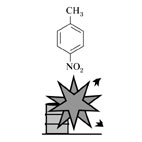| Case Name |
Burst of the reactor due to leaked water into the p-nitrotoluene sulfonic acid reactor |
| Pictograph |

|
| Date |
January 18, 1965 |
| Place |
Itabashi, Tokyo, Japan |
| Location |
Chemical factory |
| Overview |
In a p-nitrotoluene sulfonic acid manufacturing plant, the reaction was carried out at 105-110 °C. After the reaction had finished, water was fed in the jacket to cool the reactor down to 40 °C. However, the cooling water invaded into the inside of the reactor, since a crack had been generated on the reactor internal wall near the pipe of the cooling jacket outlet. The temperature in the reactor rose because of dilution heat of sulfuric acid. Since an abnormal sound was heard at that time, the circulation of the cooling water was stopped. In addition, the temperature of the reactor rose to 150 °C. Then, contents were discharged in a hurry. However, the burst occurred because there was no enough time. |
| Incident |
In the reactor of a nitrotoluene sulfonic acid manufacturing plant, the cooling water was run into the jacket after finishing the reaction. An abnormal sound was heard, and the circulation of the cooling water stopped. As the temperature of reactor rose, contents were discharged. However, the reactor burst because there was no enough time. |
| Processing |
Manufacture |
| Individual Process |
Reaction |
| Process Flow |
Fig3.Unit process flow
|
| Chemical Reaction |
Sulfonation |
| Chemical Equation |
Fig2.Chemical reaction formula
|
| Substance |
Fuming sulfuric acid, Fig4 |
| p-nitrotoluene, Fig5 |
| p-nitrotoluenesulfonic acid, Fig6 |
| Type of Accident |
Burst |
| Sequence |
In the p-nitrotoluene sulfonic acid manufacturing plant, 750kg of fuming sulfuric acid (22%) was charged into the stainless reactor with a jacket, and 275kg of p-nitrotoluene was put in. After about 1 hour reaction at 105-110 °C, the cooling water was run into the jacket, and the cooling down operation was started to about 40 °C. At that time, an abnormal sound was heard, and the circulation of the cooling water stopped. The temperature of the reactor rose to 150 °C afterwards. Although the contents were discharged, the reactor burst because there was no enough time. |
| Cause |
A crack had been generated on the internal wall of the reactor near the pipe of the cooling jacket outlet. It was supposed that the cooling water invaded into the reactor inside and the abnormal temperature rise occurred by heat of dilution of sulfuric acid. |
| Countermeasures |
1. The inspection of facilities including the reactor is strengthened.
2. Improvement in education and training of the countermeasures in unusual circumstances to the operators.
3. Study of non-reactive refrigerants with fuming sulfuric acid or taking mechanical measures to prevent water leakage. |
| Knowledge Comment |
In the sulfonation reaction, exothermic reaction occurs when water is fed into the reactor because there is concentrated sulfuric acid in the reactor. Therefore, the temperature rises and a runaway reaction is caused. On the other hand, the water is used for cooling and heat removal of the reactor. There is a hazard of water leaking into the reactor by generation of cracks or corrosion of the water piping and/or the reactor, so, it is important to check in order to prevent such leakage. If possible, it is necessary to prepare the structure in which water doesn't come in contact with sulfuric acid even if it leaks. |
| Background |
1. There was an imperfection in the inspection of the plant facilities.
2. There were structural defects. Water came directly in contact with sulfuric acid when the partition was damaged. |
| Incidental Discussion |
When leakage of water from the jacket is not permitted like this accident case, it is better to install a double partition, for example heat insulation with a coil on the outside of the vessel, or sticking the panel for heating and cooling and so on. However, the heat transfer efficiency becomes worse. |
| Reason for Adding to DB |
Example of accident caused due to the incomplete inspection of facilities and inadequate countermeasures for abnormal reaction |
| Scenario |
| Primary Scenario
|
Poor Value Perception, Poor Safety Awareness, Inadequate Safety Countermeasure, Insufficient Analysis or Research, Insufficient Practice, Lack of Imagination, Sulfonation Reaction, Planning and Design, Poor Planning, Poor Design, Usage, Maintenance/Repair, Insufficient Observation, Failure, Abrasion, Opening, Bad Event, Chemical Phenomenon, Abnormal Reaction, Secondary Damage, External Damage, Explosion, Bodily Harm, Injury
|
|
| Sources |
Japan Assoc. of Fire Science and Engineering, Chemistry fire committee, C.3.2, The nitro compound, Case 204, Chemistry fire examples (2), pp.77-78(1974)
Masamitsu Tamura, Masahide Wakakura, Explosion of p-nitrotoluene sulfonic acid, reaction hazard, -Accident case and analysis -, p.107(1995)
|
| Number of Injuries |
1 |
| Physical Damage |
The reactor was damaged. |
| Financial Cost |
¥ 2 million. |
| Multimedia Files |
Fig4.Chemical formula
|
|
Fig5.Chemical formula
|
|
Fig6.Chemical formula
|
| Field |
Chemicals and Plants
|
| Author |
OGAWA, Terushige (Graduate School of Environment and Information Sciences, Yokohama National University)
TAMURA, Masamitsu (Center for Risk Management and Safety Sciences, Yokohama National University)
|
|